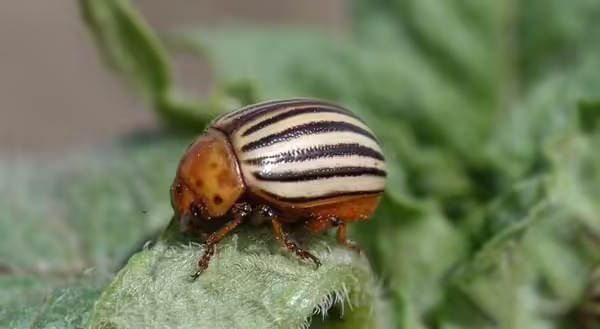
Here at the Pesticide Safety Education Program, we discuss pesticide resistance topics, such as rotating pesticide chemistries, utilizing thresholds, and using non-chemical control practices such as biological or cultural control. These topics are essential in preventing pest resistance issues, but they often miss the why and how. Why do these practices help prevent or slow resistance? How does resistance naturally occur? Why are whole populations changing and becoming resistant to specific pesticides? In insects, the causes and development of resistance are often consistent. Hopefully, through understanding the insights below, applicators will be better motivated and cognitive of integrative practices that we usually preach, which delay insecticide resistance.
Overview
The concept of resistance is generally straightforward. An applicator has an insect pest population in need of management, and the obvious option is often to use an insecticide. Before an application, an insecticide choice will need to be made to balance effective control with application and chemical costs. Due to their low cost and broad-spectrum control, there has been an overreliance on insecticides such as pyrethroids including bifenthrin or lambda-cyhalothrin in urban and agricultural settings,. In agriculture, an applicator might make a bifenthrin application early in the growing season and then again later in the season to either target another pest species or add to the tank during an herbicide application as extra insurance. In insect species with one generation per year, repeated exposure to bifenthrin can eliminate the susceptible population within the field, leaving many individuals who can overcome the treatment. In urban settings, an applicator may already have a tank with lambda-cyhalothrin and apply it multiple times a year. A pest insect such as German cockroaches can have up to 6 generations per year and a limited intermating gene pool that allows resistance to develop quickly in this environment. Depending on the insect and method of resistance, the specific insecticide or insecticide class may lose effectiveness in its control.
Genetics
When it comes to talking about insecticide resistance, there is much talk about genetics, so let's go back to high school biology class to figure this out (I know I’ve tried to block high school out too, but bear with me for a second). So, the concept lies in dominant and recessive genes. It takes one dominant copy of a gene to express a trait but two recessive copies of a gene to express that trait. Let's take eye color as an example and the pairings of genes that cause brown (“B” gene) and green (“g” gene) eyes. If a combination of genes are passed down from parents that result in BB or Bg, then the offspring will have brown eyes. If the parents pass down two gg genes, the offspring will have green eyes. Simple enough, right?
The same concept applies to insecticide resistance. For the average synthetic insecticide, when new chemistry is introduced to the market, naturally occurring resistance in the target species is often close to existing naturally at a sometimes-undetectable level. As insecticide use continues, the population of SS (susceptible)or Sr (susceptible but has inherited the gene for resistance which is not expressed) is killed off, increasing the proportion of rr (resistance) insects. Without insecticides, it is disadvantageous for the insect to have traits that cause resistance, often due to effects on the production of other proteins, decreased size, or changes in other characteristics that make them perceived as less desirable to potential mates. Low resistance levels are acceptable, but once the population reaches 20% resistance, the usefulness of the insecticide is often considered lost.
Now, we must ask what a resistant trait is. Resistance can occur in many ways. One of the more common ways is targeting how the insecticide interacts with its target site within the insect. Insecticides effectively enter the insect and bind to a highly specific site or protein within the body to interrupt physiological processes. Many insecticides target the insect's nervous system by interrupting how signals to muscles are passed throughout the body. If the binding site were to change slightly, the insecticide may not bind as well and allow the insect to survive the dose.
Similarly, an insect can increase the production of detoxification proteins so the chemical cannot remain in the body long enough to reach its target site. Externally, the insect may increase its wax coating or cuticle thickness to prevent contact insecticides from entering the body. Alternatively, insects can develop behavioral changes to sense and avoid insecticides, so they do not come in contact with a lethal dose. While these are all possibilities, it depends on the insecticide’s target insect, target site, and route of exposure.
Exceptions to the rule
Due to the diversity of insects, the way most pest insects overcome insecticides is not the way all pest insects overcome insecticides. While it has already been stated that repeated exposure and generations per year can impact the speed of resistance in a population, different species will develop resistance differently. Aphids practice an asexual reproduction habit called parthenogenesis, where females can make exact copies of themselves and pass down their resistance. The Colorado potato beetle is infamous for its ability to develop resistance to insecticides after only a handful of applications and is now resistant to around 50 insecticides. They do this through multiple processes working together to overcome insecticide applications. The diamondback moth has been known to become resistant through dominant or incomplete dominant genes where both parent genes influence protein expression. Again, these are unique cases of insecticide resistance, but it is important to know that insects can resist through other mechanisms.
Conclusion
With a better understanding of how insecticide resistance occurs, we are hopeful that producers and pesticide applicators will be more likely to employ integrative practices which help delay insecticide resistance.
Pictured above: Colorado potato beetle
Photo credit: Ward Upham, Kansas State University, Bugwood.org
ABOUT THE AUTHOR: John Schepis provides subject matter expertise and training in pesticide safety with an emphasis on entomology.